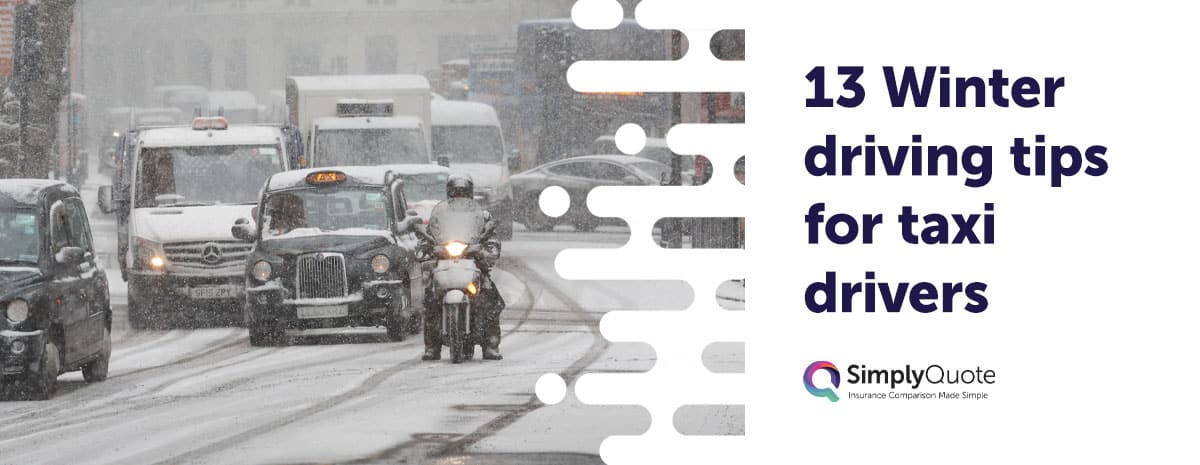13 Winter driving tips for taxi drivers
Taxi drivers can prepare for winter weather by making sure their vehicles are equipped to deal with icy roads, staying alert to weather warnings, driving safely, and having a winter driving kit on hand.
In this guide, we’ll cover 13 winter driving tips to keep you and your passengers safe and smiling.

Tip 1: Check your tyres
A taxi’s tyres must meet the legal tread depth of 1.6 mm, but tyre experts and mechanics recommend a tread of at least 3 mm.
Deeper treads allow for a better grip and improved braking, while tyres with a shallower tread have decreased stopping distances which are exacerbated by wet conditions.
Opt for all-season or winter tyres as an added safety measure. While these aren’t a legal requirement, they’re a good idea if you drive in areas prone to dense snow.
Additionally, remember to check your tyre pressure regularly. The recommended Pounds per Square Inch (PSI) between 32 PSI and 35 PSI is suitable for all types of weather.
Bonus read: 19 Safety Tips For Taxi Drivers
Looking for cheap taxi insurance? Get your quote today!
Get QuotesTip 2: Make sure you have adequate battery health
Your vehicle’s battery is its lifeline. Colder temperatures can inhibit the internal chemical reactions which are vital to its functioning.
Here’s how you can maintain battery health in winter:
- Park your vehicle in a garage, if possible.
- Invest in a car battery booster for emergencies.
- Start your car regularly.
- Opt for a battery blanket in the winter months.
- When starting your vehicle, ensure all electronic connections (radio, connected chargers) are switched off.
Tip 3: Use antifreeze and specialised screen wash
Your antifreeze or coolant levels should be at their maximum throughout the year – even more so in winter.
High-quality antifreeze:
- Prevents the engine cooling system water from freezing.
- Helps the engine block maintain even temperatures.
- Protects the engine from scale build-up, rust and corrosion.
Specialised winter screen wash is a necessity in winter. Winter screen wash is designed to remove salt, snow, and ice from the road.
Tip 4. Check your lights and electrics
A thorough check of your vehicle’s electrical components should be carried out before winter creeps in, especially for headlights and brake lights. Replace dim or blown bulbs as soon as possible, as this can lead to bigger problems further down the road.
Tip: Even when driving during the day in winter, it’s recommended that you turn on your headlights or fog lights. This increases your vehicle’s visibility and allows for safer driving.
Tip 5: Ensure wipers work properly
Windscreen wipers should be changed every six to 12 months. If possible, try to align the change with the upcoming winter season.
Drivers could also opt for winter wiper blades, designed to combat the weather more effectively due to their larger and sturdier nature.
Just be sure to check the functionality of your new wiper blades before heading out onto the roads.
Tip 6: Drive cautiously
As a taxi driver, you’re legally required to exercise safe driving regardless of the season. However, your driving habits will need slight adjusting to accommodate challenging weather conditions.
You can be extra cautious by:
- Steering gently
- Being wary of other drivers on the road
- Leaving extra space between your vehicle and the one ahead of you
- Monitoring your stopping distances, especially in wet conditions
- Braking gently
Tip 7: Have a fully stocked emergency kit
You should always have a fully stocked emergency kit in your taxi vehicle. However, an upgraded winter driving kit is essential in low temperatures. Drivers must be prepared for the cold weather and any associated hazards, situations, or delays.
A winter emergency kit should contain:
- Snow shovel
- Ice scraper
- Warm blanket
- Warning triangle
- High visibility jacket or vest
- Flashlight
- Bottled water
- Chargers
- Empty fuel canister
- Sunglasses
- Food
- Jumper leads
- Extra clothing
Tip 8: Keep your tank full
Taxi drivers must have enough fuel to offset added driving time or delays caused by winter weather.
Winter weather means rain, fog, snow, and icy roads, which often results in delays. The average driving time may also be longer in winter months as many road users will (hopefully) be more careful and drive slower.
The last thing you need is to suddenly run out of fuel, so keep your fuel tank topped up and note nearby petrol stations along your route – just in case.
Tip 9: Stay updated with weather forecasts
Taxi drivers should use accurate weather and news apps to better prepare themselves for the day’s work.
Remember to change the settings on your app to allow immediate notification of any urgent weather reports. Keep an open line of communication with your dispatcher and other drivers to warn them too.
Tip 10: Be wary of road conditions
Drivers should use apps such as Waze during winter to be notified of road closures, heavy traffic, accidents, or potential hazards caused by inclement weather. Again, be sure to communicate these situations with other drivers and dispatchers so that they can avoid them, too.
Bonus read: Best Apps For Taxi Drivers
Tip 11: Watch out for black ice
Snow and ice are standard features of UK winters, but black ice is especially dangerous. In fact, more than 10% of UK winter car accidents are a result of black ice.
Black ice is more compact and has a smoother surface, making it harder for drivers to gauge whether it is ice or the road.
What to do if you hit black ice
If you do encounter black ice and cannot avoid it, do not brake hard. While this may be your natural instinct, it could cause your vehicle to spin.
Instead:
- Take your foot off the accelerator.
- Lightly tap your foot on the brake pedal. DO NOT slam the brake pedal hard.
- Shift down a gear.
- Look out for any potential hazards (trees, other cars) ahead of you.
- If your car starts skidding, turn your steering wheel in the same direction as the skid.
- Remain calm and slowly direct your car to a safe area.
Tip 12: Take your passenger’s safety and comfort into consideration
Even with the added stress and challenge of cold weather, your customer service should still be a top priority. Being a good taxi driver is essential to your brand’s reputation but is equally important for the safety of your passengers.
For example, you could offer your passengers a clean blanket to use during their ride and have an umbrella on hand when they step out.
Additionally, investing in comprehensive taxi insurance is a surefire way to ensure both your and your passengers’ safety, as you never know what can happen when behind the wheel.
Insurers often refer to taxi insurance by several names:
Tip 13: Know when not to drive
Taxi driving may be your livelihood, but it is not worth putting your safety at risk during bad weather. Use your judgement to decide if you want to drive during certain conditions – weather warnings are there for a reason, after all!
If you have been advised not to go on the road, don’t go on the road. These are not guidelines. Engaging in risky behaviour could be harmful to not only yourself but also to your passengers, pedestrians, and other road users.
Bonus read: Taxi Driver Problems And How To Deal With Them
Final thoughts
There are many ways to drive safely in winter, from checking tyre treads and car batteries to watching for black ice and paying attention to weather forecasts – and more!
Taxi drivers should invest in comprehensive taxi insurance to ensure their own safety, that of their vehicles, and their passengers.
Use SimplyQuote‘s 100% free, online comparison tool to compare insurance quotes this winter – the UK’s #1 comparison site for taxi drivers.
Frequently Asked Questions
The legal number of hours (40-45 hours a week) won’t change in winter. However, some drivers may opt to drive fewer hours due to poor visibility and fewer daylight hours. All taxi drivers must be aware of the legalities associated with shift work. For more insight read: UK Taxi Driver Shifts Explained.
For emergencies of any kind, taxi drivers can call 999 to report an incident that requires immediate attention. The dispatcher will send the appropriate team to assist you. For non-emergency situations, dial 101.
When driving in snow, remember to wear appropriate footwear, accelerate gently, and reduce your speed. If you are on a highway, try to reduce your speed by half the legal limit. It’s recommended that drivers adhere to 30 mph in snowy conditions and 15 mph if the roads are packed with snow.
